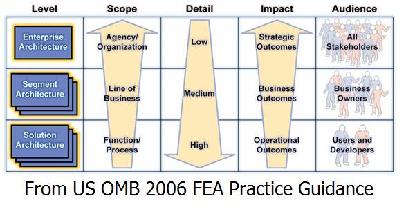Enterprise Architecture is the description of the current and/or future structure and behavior of an organization’s processes, information systems, personnel, and organizational sub-units, aligned with the organization’s core goals and strategic direction. Although often associated strictly with information technology, it relates more broadly to the practice of business optimization in that it addresses business architecture, performance management, organizational structure, and process architecture as well.
Modeling the Enterprise Architecture is becoming a common practice within the US federal government to inform the Capital Planning and Investment Control (CPIC) process. The Federal Enterprise Architecture (FEA) reference models serve as a framework to guide Federal Agencies to development their architecture. The primary purpose of creating an enterprise architecture is to ensure that business strategy and IT investments are aligned. As such, enterprise architecture allows traceability from the business strategy up to the underlying technology.
TeKnoFirm helps clients to make use of enterprise architecture to improve their business architectures as well as to improve business performance and productivity.
The architecture process addresses documenting and understanding the discrete enterprise structural components, typically within the following four categories:
- Business:
- Strategy maps, goals, corporate policies, Operating Model
- Functional decompositions (e.g. IDEFo, SADT), capabilities, and organizational models
- Business Processes
- Organization cycles, periods, and timing
- Suppliers of hardware, software, and services
- Applications:
- Application software inventories and diagrams
- Interfaces between applications – that is: events, messages, and data flows
- Intranet, Extranet, Internet, eCommerce, EDI links with parties within and outside of the organization
- Information:
- Metadata
- Data Models: conceptual, logical, and physical
- Technical:
- Hardware, platforms, and hosting: servers and where they are kept
- Local and Wide Area Networks, Internet Connectivity diagrams
- Operating System
- Infrastructure software: Application servers, DBMS, etc.
